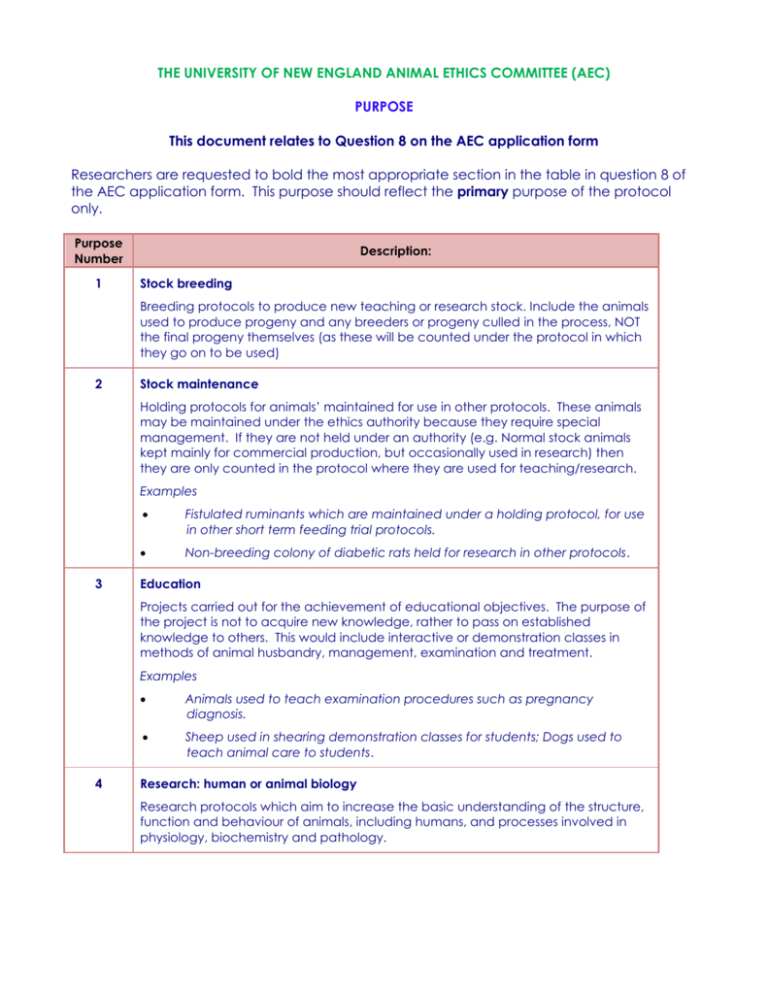the university of new england animal ethics committee (aec)
advertisement

THE UNIVERSITY OF NEW ENGLAND ANIMAL ETHICS COMMITTEE (AEC) PURPOSE This document relates to Question 8 on the AEC application form Researchers are requested to bold the most appropriate section in the table in question 8 of the AEC application form. This purpose should reflect the primary purpose of the protocol only. Purpose Number 1 Description: Stock breeding Breeding protocols to produce new teaching or research stock. Include the animals used to produce progeny and any breeders or progeny culled in the process, NOT the final progeny themselves (as these will be counted under the protocol in which they go on to be used) 2 Stock maintenance Holding protocols for animals’ maintained for use in other protocols. These animals may be maintained under the ethics authority because they require special management. If they are not held under an authority (e.g. Normal stock animals kept mainly for commercial production, but occasionally used in research) then they are only counted in the protocol where they are used for teaching/research. Examples 3 Fistulated ruminants which are maintained under a holding protocol, for use in other short term feeding trial protocols. Non-breeding colony of diabetic rats held for research in other protocols. Education Projects carried out for the achievement of educational objectives. The purpose of the project is not to acquire new knowledge, rather to pass on established knowledge to others. This would include interactive or demonstration classes in methods of animal husbandry, management, examination and treatment. Examples 4 Animals used to teach examination procedures such as pregnancy diagnosis. Sheep used in shearing demonstration classes for students; Dogs used to teach animal care to students. Research: human or animal biology Research protocols which aim to increase the basic understanding of the structure, function and behaviour of animals, including humans, and processes involved in physiology, biochemistry and pathology. Purpose Number 5 Description: Research: human or animal health and welfare Research protocols which aim to produce improvements in the health and welfare of animals, including humans. 6 Research: animal management or production Research projects which aim to produce improvements in domestic or captive animal management or production. 7 Research: environmental study Research protocols which aim to increase the understanding of the animals’ environment or its role in it, or aim to manage wild or feral populations. These will include studies to determine population levels and diversity and may involve techniques such as observation, radio tracking or capture and release. Example 8 Pre-logging or pre-development fauna surveys. Production of biological products Using animals to produce products other than milk, meat, eggs, leather, fur, etc. Examples 9 Use of a sheep flock to donate blood to produce microbiological media Production of commercial anti-serum. Production of products, such as hormones or drugs, in milk or eggs from genetically modified animals. Quality assurance testing of drugs but do not include animals which come under code 10, below. Diagnostic procedures Using animals directly as part of a diagnostic process. Examples 10 Inoculation of day old chicks with ND Virus to determine virulence Blue-green algae toxicity testing Water supply testing using fish Regulatory product testing Protocols for the testing of products required by regulatory authorities, such as the APVMA. If the product testing is not a regulatory requirement, e.g. It is part of a quality assurance system only; those animals should be included in the appropriate category selected from above. (This would be normally be category 8 in the case of QA testing) Example Pre-registration efficacy or toxicity testing of drugs and vaccines.











